︎︎︎BLACK BOX
march to october 2021
In this first edition, the objective was to unveil the institutional racism through the reality of precarious temporary migrants, alluding to the discrimination and violation of rights of illegal workers both in the south of Spain and in the big cities of the country. In order to start this way of approaching such conflicts, in 2021 we were ourselves as Todo por la Praxis we are the ones who carry it out, in order to promote this work methodology of the collective.

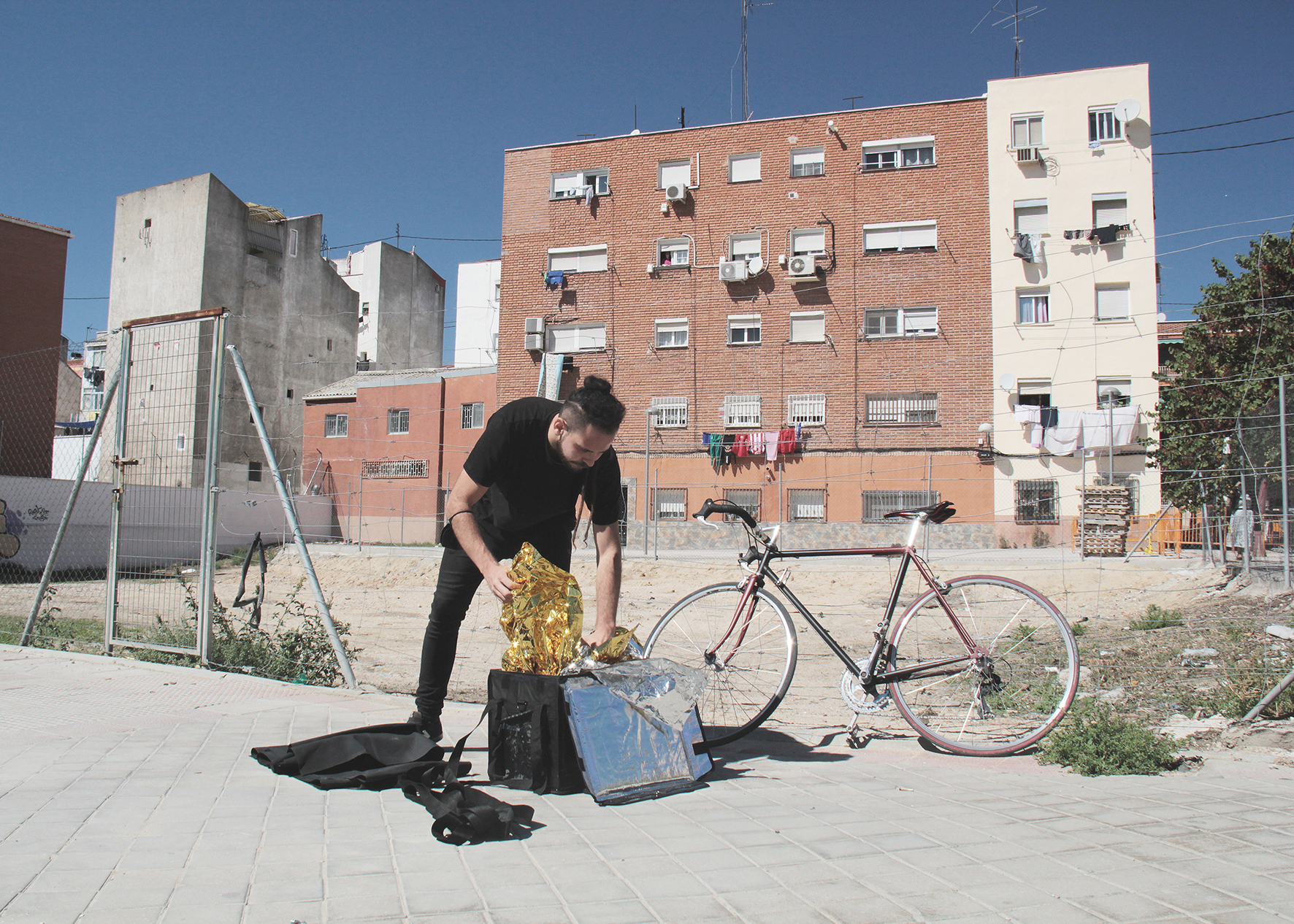


Street action with the "house - package”
During the COVID-19 pandemic, we have witnessed how the inequalities of an unjust system that were already here, but which by force majeure have become more visible, have increased. When the curfews paralyzed the cities, we still saw the riders with their bicycles riding from one place to another, delivering quickly those orders that we seemed to need so urgently. On the other hand, when social distance and open spaces were imposed, les temporeres inhabited settlements that did not meet the minimum conditions under the passivity of the competent authorities with racist strategies, which have begun to be fought by organizations and collectives. The violation of human rights that has been taking place for more than twenty years in these areas has only increased due to the social and health crisis.
We could reflect on some elements that this situation forces us to look at closely and that should not be forgotten once it has passed: the growing inequality of the capitalist system, the precariousness of working conditions and housing problems. We could say that the combination of these elements is reflected in several groups of people, but if there are people who personify all three, it is les temporeres and les riders.
Deployed throughout the peninsula, the collection campaigns in the fields have become constant sources of inequality and precariousness. In 1997 the General Union of Workers (UGT) published a report in which it warned that the lack of housing would lead to an increase in the number of people living on the streets and would eventually force the creation of shanty towns and settlements as the only housing solution. The predictions have been fulfilled under the complete lack of interest of the Administrations, which have preferred to look the other way while allowing continuous and systematic violence. The term shantytown is defined by the Pan-Hispanic Dictionary as: "Poorly constructed substandard housing that is usually built in suburban areas and lacks the basic services required", its etymology comes from the French geôle (cell, prison) through the Basque txabola. The French term comes from the Latin caveolla, which is a diminutive of cavea, meaning cell, cage. And in part, it is also what shantytowns become for the people who are forced to inhabit them, cages of constant precariousness that mark and determine their possibilities and rights to have a decent life and work.
These temporary camps and their precarious dwellings appear in different parts of the Spanish geography, highlighting some spots in Huelva, Murcia, Lleida and Almeria. As a visual device, they resemble the packages that the migrants themselves transport from one territory to another with their belongings, images that are repeated at borders such as Ceuta and Morocco.
Parallel to this is the simultaneous reality that mirrors what this package means, in which the same logics of exploitation and domination of the migrant are reproduced, a precariousness that is assumed to be contemporary but which in practice is contemporary, the rider. This home food delivery service for digital platforms has as one of its main and characteristic means of production, a large thermal backpack that resembles a bulky package.
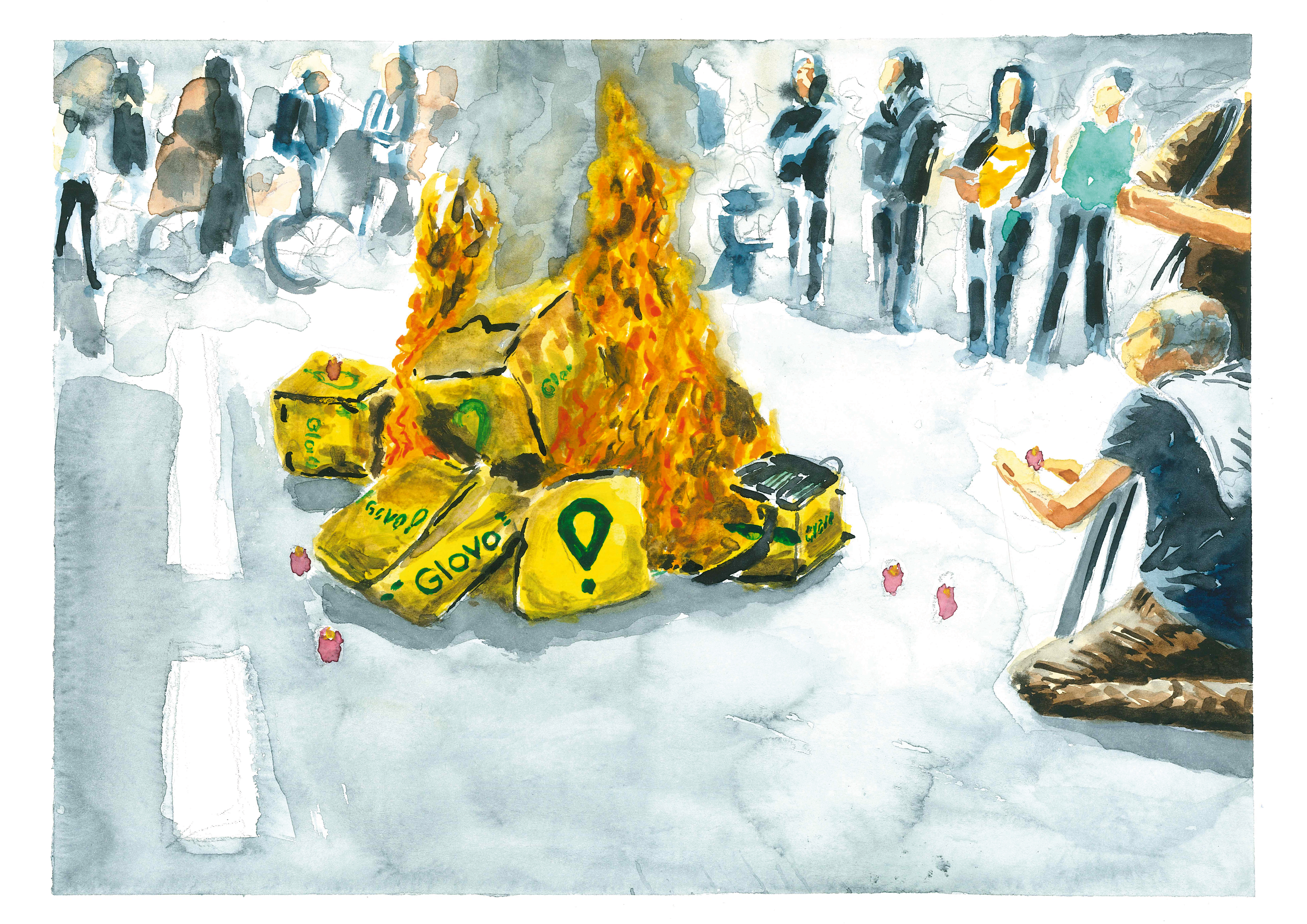
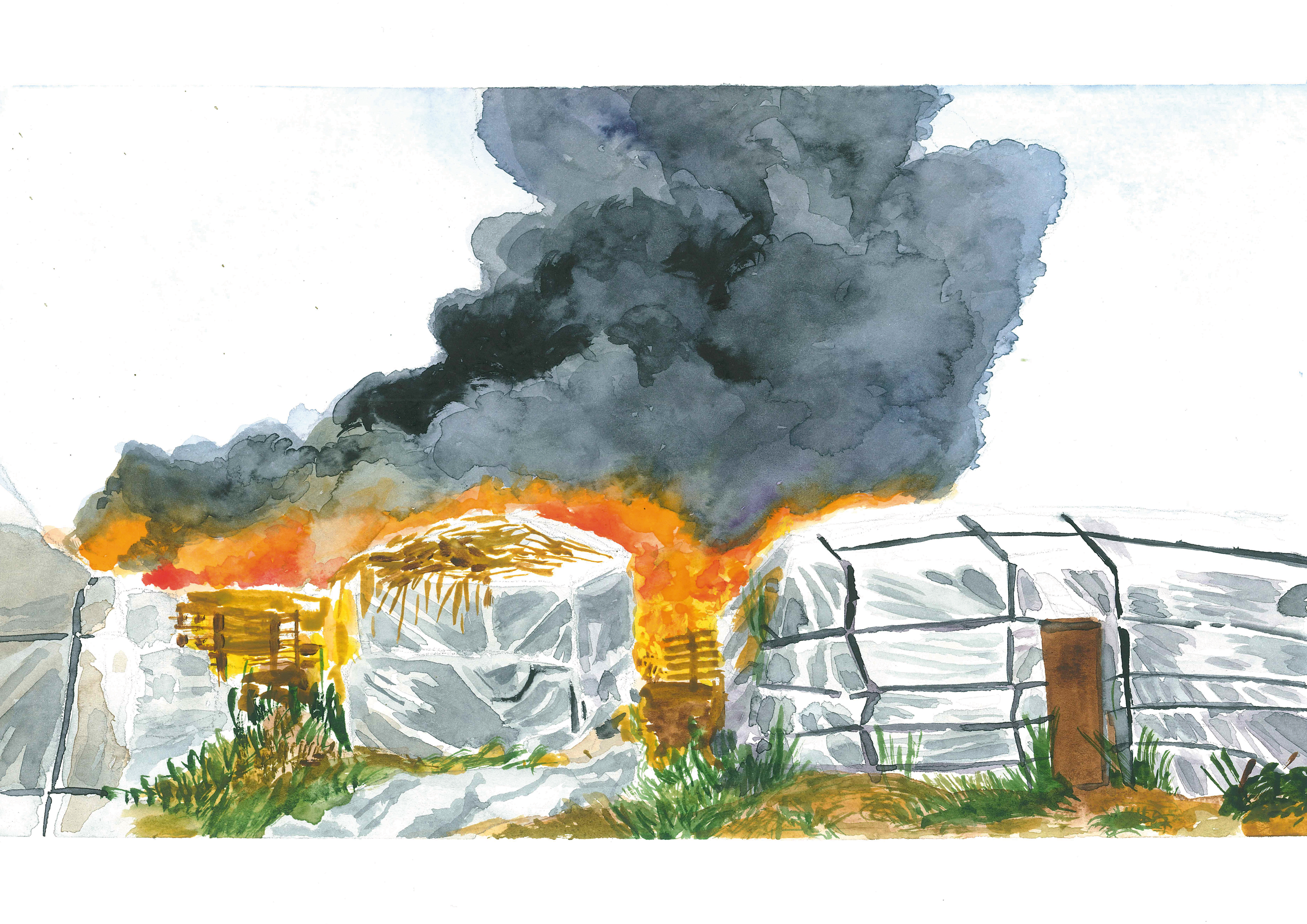

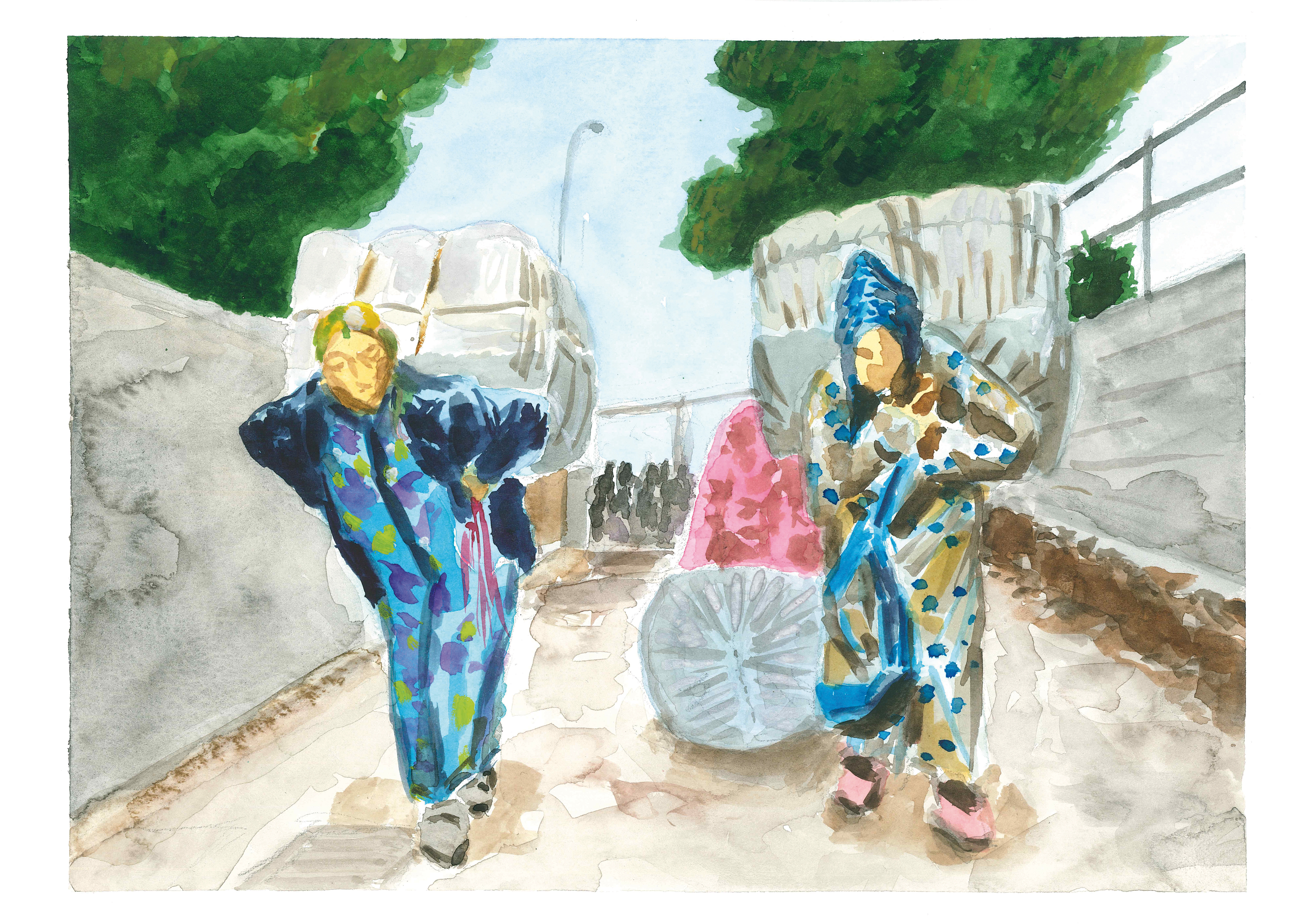


Watercolors by Fernando Ossandón (CL) based on photographs from newspaper archives.
The last few years have also been very turbulent for these riders from companies such as Glovo or Deliveroo. For some time the unions have been warning of the precariousness and bad practices of these companies and the problem that the figure of the false self-employed was going to suppose. The support of the various unions, coupled with the deaths of some of the workers, such as the 22-year-old young man in Barcelona on May 26, 2019 or the most recent, which occurred in Madrid on February 9, 2021, have generated all kinds of protests, one of the most shocking being the one that took place in Barcelona with the burning of the backpacks. An image with a strong impact that has pushed us to reflect on fire as an ambivalent tool, as a possible element from which to express the anger and weariness for the constant precariousness of the riders, facing long working days, in a model that forces you to work long hours to live, crossed by conditions without guarantees or protection against occupational hazards and accidents. But fire can also become an element of expulsion, such as the constant fires in the temporary settlements. At least one fire has been registered every six months in the Lepe settlement near the municipal cemetery, and these have been used to carry out the expulsion of the temporeres. Some municipalities and the Autonomous Communities have decided to demolish some of these settlements and then fence them off, without offering any alternative housing.
Terms such as precarity, precarization or precarious work have acquired greater importance, perhaps with a greater presence initially in activism. Judith Butler, inspired by Michel Foucault, reflected in Precarious Life: The Power of Mourning and Violence on the possibility of resistance to the productive power of precarity and how the very conditions of precarity can contain the potential to recognize our relation to others and provide a position in which to embrace each other's vulnerability and create an alliance of bodies. Guy Standing in his essay published in 2011 The Precariat. The New Dangerous Class, begins with a series of questions, one of them being crucially "Where is precarity taking us?".
The numerous violations that these realities mean in terms of human dignity, children's rights or violence against women seasonal workers and riders, have made us consider the political and radical importance of activating this work. We connect both imaginaries as a starting point for this research that addresses urban phenomena in crisis to detonate questions and establish dialogues that question them. The historical review of both issues, built from a work of newspaper archive and research, has led us to the need to generate a work that allows us to put in crisis the reality of these migrant precariousness.
From this, we have created a housing device that reflects on the condition of life of the temporary/legal worker together with a lifestyle that has been disguised behind the concept of entrepreneur and adventurer, within a neoliberal and atomized labor system. In an ironic reflection on housing as a product of the market, we try to build a fake, which is not so far from reality, where the shack has become a commodity marketable through the same platforms of sale and circulation that are behind the exploitation of the precarious migrant. In this opportunity, the work is auctioned on the buying and selling platform Ebay, bringing a conceptual circularity to the project.
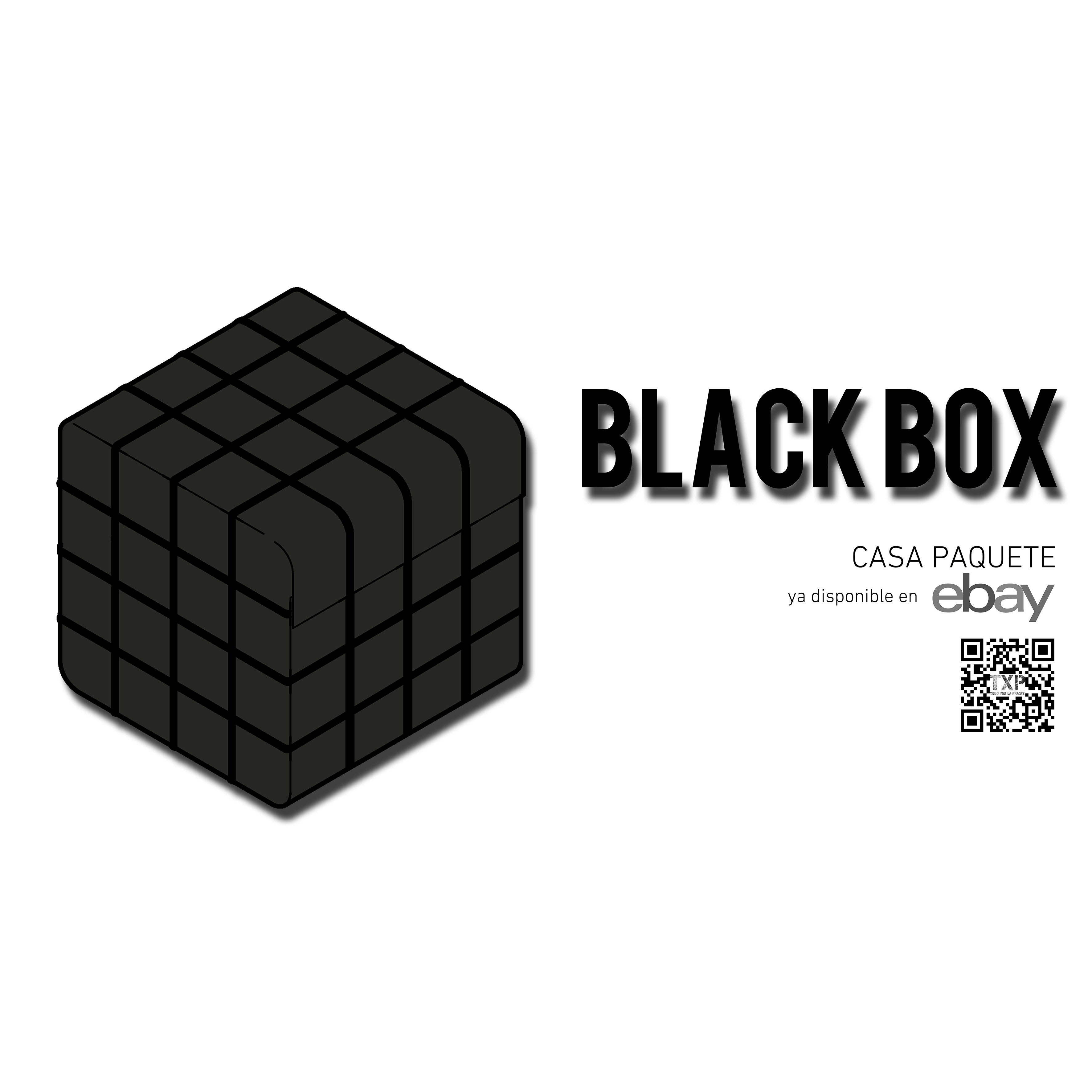 Image of the sale of the work, which was placed on the front of the Espacio de Todo.
Image of the sale of the work, which was placed on the front of the Espacio de Todo.In addition to the creation of this "house-package" that is accompanied by an assembly manual with a strong ironic charge, the work has a series of elements that customize this contradictorily inhabited space. Seven watercolors and a table made with the signage of the Spanish border as part of the European Union, are part of the sale and staging of this device. In addition, it is accompanied by some counter-advertising banners that have been elaborated with texts that derive from Mike Davis' phrase "housing is a verb", combining it with different verbs associated to the reality that we have approached. The activation of this set has a continuity in time through its circulation in the public space.
 Elaborated banners to customize the "house-package".
Elaborated banners to customize the "house-package".Because this project, more than a housing response, has been thought as an instrument of interpellation on the precarious living conditions of these collectives and their reproductive elements, with the package as an element with a strong symbolic charge that somehow dominates the iconography of the migrant.
This mirror centered on the package opens cracks and fissures from which to establish dialogues between realities that are not directly connected, but which arise from the same logics of power that define a story. The imaginary of the package they carry and inhabit becomes a constant in the reality of migrants who travel on a journey of expulsion and subjugation that drives them to live in a condition of transience and permanent nomadism. Their content is their continent to the point of inhabiting it in a symbolically perverse production.





Manual for the assembly and use of the "house-package"
With this critical design we wanted to put on the table the problems derived from the systematic abandonment of vulnerable populations in a context of illegal exploitation of temporary workers, the precarious living conditions and the episodes of expulsion that have been carried out from the burning of these camps and what lies behind, racism and continued invisibilization. We are interested in the term Black Box, and hence the title of the work and the project, because of the social process that the very notion of black box implies. The one that starts from the ways in which the system and the people who suffer from it have been affected by the invisibilization that financial or economic success itself produces, because the complexities that live inside this success are not analyzed. Only the benefits derived from it are analyzed. The idea of Black Box is based on how people can forget the inner processes of things as we begin to assimilate them by an everyday use extended in time, which is precisely what has been happening with riders and temporeres in our daily lives.
*For this project have worked with Todo por la Praxis the art historian Fidel Villar Barquín (ES) in charge of the research, the visual artist Fernando Ossandón Zubieta (CL)* who has made the watercolors that are part of the project, and Sergio Cabrera (ES) as a collaborator.
︎Opening of the "BLACK BOX" process
october 2, 2021

*You can see the recipe that we prepared as Todo por la Praxis for the opening of the process at ︎︎︎Recipes
*Fernando Ossandón Zubieta (Viña del Mar, 1973)
Born in the region of Valparaíso, Chile, he studied at the School of Fine Arts in Viña del Mar. He has been dedicated to the field of visual arts and cultural management, exhibiting his works from painting, graphic and video art in spaces in Chile, Mexico, Argentina, Peru, Bolivia, Sweden, Spain and Poland. He has collaborated in literary publications, television and cultural programming. Since 2005 he lives in the city of Iquique, Chile.